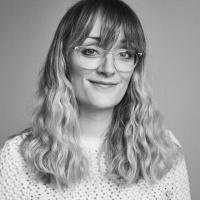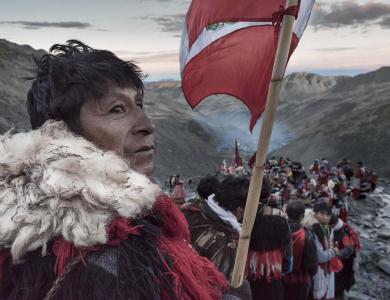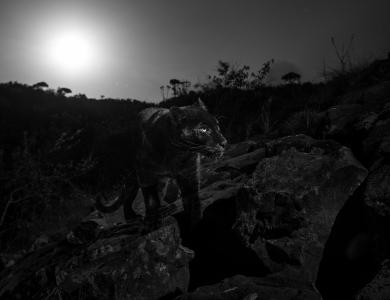
Lucas Foglia grew up on a small farm, 30 miles east of New York City. Growing their own food, his family felt shielded from the strip malls and suburbs that surrounded them. The forest bordering his family farm was a wild place where Lucas would play as a child. In much of Lucas' work, particularly his latest book Human Nature, he explores the complex relationship between people and nature. Lucas has won 15 awards and his photographs have been exhibited extensively worldwide. Lucas' work is held in major collections, including Foam Fotografiemuseum (Amsterdam), International Center of Photography (New York), San Francisco Museum of Modern Art and Victoria and Albert Museum (London).
Lucas takes over our Instagram feed for the week (June 30 to July 6), sharing work from his project Human Nature. We caught up with Lucas to discover more about his work.
Human Nature looks at seven different ecosystems and gives insight into the people working towards a more sustainable environmental future. What do you think this positive approach to such a sobering subject brings?
Conservationists often disagree about how humankind should best move forward from the damage we have already done. Traditionalists argue that we should put a boundary around wild spaces to preserve them, but there is no way to contain the effects of people. More radical conservationists propose moving all people to green cities, supplied with renewable energy and sustainable agriculture, so the countryside can re-wild itself.
Responding to this debate, I befriended and photographed people who are working towards a positive environmental future despite the enormity of the task. Human Nature is a series of interconnected stories about our reliance on the natural world and the science that fosters our relationship to it. Each story is set in a different ecosystem: city, forest, farm, desert, ice field, ocean, and lava flow. From a newly built rainforest in urban Singapore to a Hawaiian research station measuring the cleanest air on Earth, the photographs examine our need for “wild" places—even when those places are human constructions.
I think it's imperative to recognize the environmental disaster for which we're responsible. And I think we need hopeful examples to reference and grow.
How do you ensure your work reaches an audience?
Hope fuels the work of the people I photograph and drives how I use their images. I exhibit prints of my photographs in galleries, festivals and museums. I publish photographs in books, magazines and on social media. I also give my photographs to local and international organizations to use for advocacy. All are different methods of storytelling, and there is activism, and optimism, in each of them.
What's the goal with Human Nature?
To share positive examples of people connecting to nature, given the ubiquitous context of climate change.
Tell us more about the people you met, was there a particularly memorable encounter you'd like to share?
Of course! I asked a researcher at the National Oceanic and Atmospheric Administration where the cleanest air was. He gave me the exact spot. The air over Cape Kumukahi on the Big Island of Hawaii has traveled across the Pacific Ocean. It's arguably the cleanest air on Earth. I went there and took a photograph of the landscape: ground, plants and ocean. It wasn’t a very good picture. Then, walking back to the road, I met a couple on their first date. It was after sunset so I asked them if they would meet me the next morning. I wanted to photograph them on their second day of knowing each other, in the cleanest air on earth. They met me the next day. During the shoot, they started kissing. That led to the photograph that closes the book.
In the text accompanying Human Nature you say how your photographs 'examine our need for “wild” places—even when those places are human constructions.' Can you elaborate on this?
Previous generations argued that wild nature should be preserved. In 2012, Hurricane Sandy flooded the fields on my family’s farm and blew down the oldest trees in the woods. On the news, scientists linked the storm to climate change caused by human activity. I realized that if humans are changing the weather, then there is no place on Earth unaltered by people.
The climate is changing because of us. In that way we are big. But we are also vulnerable to the storms, droughts, heatwaves and freezes that result from climate change. In the face of those events, I feel rather small. We still depend on nature for our safety, health and our happiness. Arguably, as the dominant species, we have a responsibility to be stewards of the world.
Your images tell a story, they inform, but they're also evocative through your use of light, colour and subject matter. Does a photograph have to be capable of evoking an emotional response to make the viewer engage with it?
Yes. A photograph has to be nuanced in color, composition, and content.
You are represented by three prestigious fine art galleries, including Michael Hoppen Contemporary in London. Why do you think your work, rooted in documentary, appeals to a fine art audience?
I believe there should be room in the art world for art about the world. I photograph because I have questions about the world and my role in it. I want my photographs to bring attention to people and places that, in my opinion, deserve attention. I also want my photographs to be complex. I want to compel viewers to think and feel without telling them what to think or feel. That is what separates art from propaganda.



